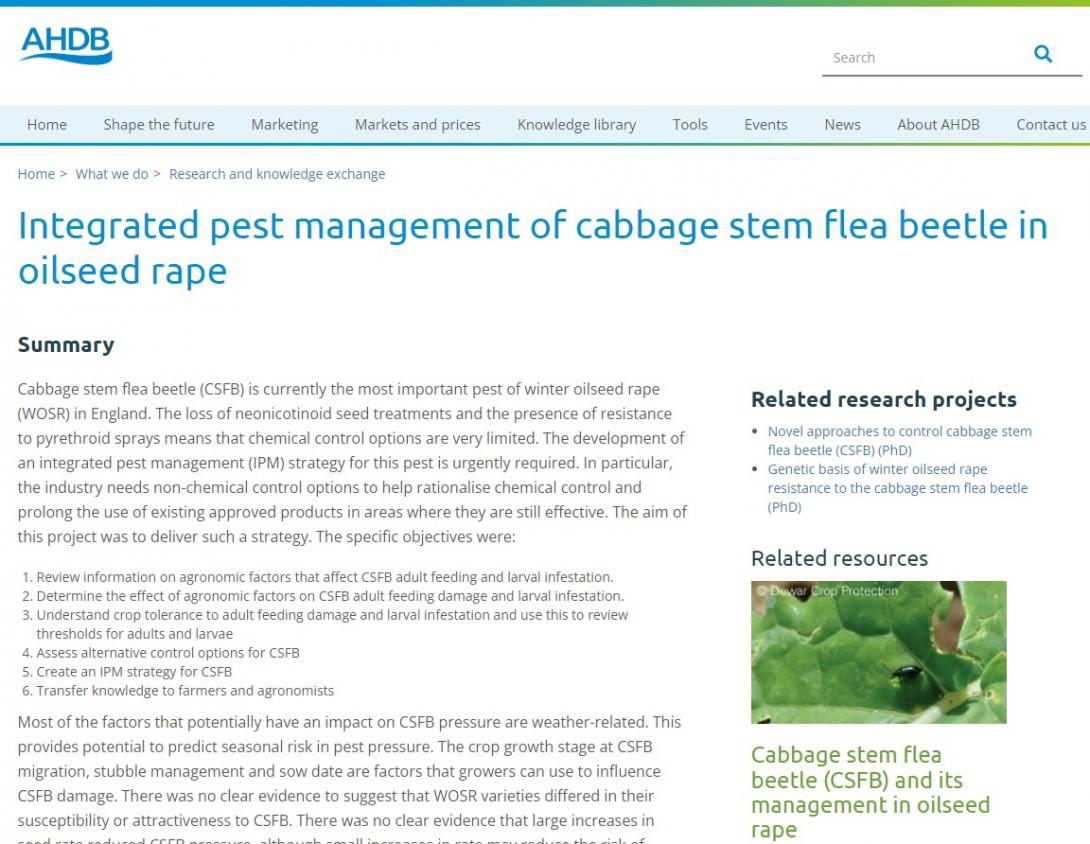Integrated Pest Management of CSFB in Oilseed Rape

AHDB Project PR623 - Integrated pest management of cabbage stem flea beetle in oilseed rape - Jun 2020 -
Sacha White , Steve Ellis, Fran Pickering , Daniel Leybourne, Isabel Corkley, Sarah Kendall, Larissa Collins, Max Newbert, Luke Cotton, Richard Phillips
Summary
Cabbage stem flea beetle (CSFB) is currently the most important pest of winter oilseed rape (WOSR) in England. The loss of neonicotinoid seed treatments and the presence of resistance to pyrethroid sprays means that chemical control options are very limited. The development of an integrated pest management (IPM) strategy for this pest is urgently required. In particular, the industry needs non-chemical control options to help rationalise chemical control and prolong the use of existing approved products in areas where they are still effective. The aim of this project was to deliver such a strategy. The specific objectives were:
- Review information on agronomic factors that affect CSFB adult feeding and larval infestation.
- Determine the effect of agronomic factors on CSFB adult feeding damage and larval infestation.
- Understand crop tolerance to adult feeding damage and larval infestation and use this to review thresholds for adults and larvae
- Assess alternative control options for CSFB
- Create an IPM strategy for CSFB
- Transfer knowledge to farmers and agronomists
Most of the factors that potentially have an impact on CSFB pressure are weather-related. This provides potential to predict seasonal risk in pest pressure. The crop growth stage at CSFB migration, stubble management and sow date are factors that growers can use to influence CSFB damage. There was no clear evidence to suggest that WOSR varieties differed in their susceptibility or attractiveness to CSFB. There was no clear evidence that large increases in seed rate reduced CSFB pressure, although small increases in rate may reduce the risk of suboptimal plant populations. Pot and field experiments demonstrated that WOSR shows tolerance to damage from both CSFB adults and larvae, which offers the chance to refine thresholds for the pest. The use of volunteer oilseed rape (vOSR), as a trap crop for adult CSFB, and/or defoliation of the crop in winter, to reduce numbers of CSFB larvae, both show promise as alternative control measures for the pest. Use of vOSR reduced adult CSFB infestation by up to 88%, damage by up to 76%, larval numbers by up to 69% and increased plant population by up to 56%. Defoliation decreased larval numbers by between 23 and 55%, but impacts on crop yield were inconsistent. The project identified 31 factors that could influence CSFB pressure. Of these, 20 decreased risk, seven increased risk and four, on balance, were neutral. Overall, the most promising tools for reducing CSFB risk are adjusted sow dates and the use of vOSR as a trap crop. Other tools also show promise. A potential IPM strategy for the pest is proposed at a range of crop growth stages, from pre-sowing until the following spring.


